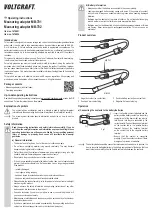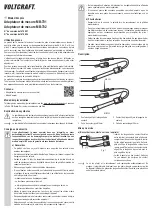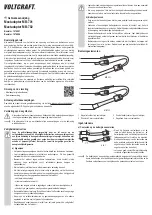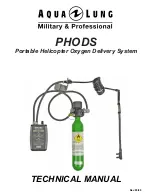
This is a publication by Conrad Electronic SE, Klaus-Conrad-Str. 1, D-92240 Hirschau (www.conrad.com).
All rights including translation reserved. Reproduction by any method (e.g. photocopying, microfilming or capturing in
electronic data processing systems) requires prior written approval from the publisher. Reprinting, also in part, is
prohibited. This publication represents the technical status at the time of printing.
Copyright 2018 by Conrad Electronic SE.
*1674851_1674854_v1_1018_02_DS_m_4L_(1)
b) Measuring voltage
The diagram below shows how to connect the adapter to a multimeter or other similar
measurement device. The measurement device is not included and must be purchased
separately. Two measuring adapters are required to measure the voltage.
Fig.2
Follow the steps below to measure the voltage on a battery connected to the load.
• Connect both measuring adapters to the battery that you want to measure. Follow the
instructions in section "a) Connecting the connecting the contacts to the battery/batteries"
to establish the connection.
•
Connect the measuring adapters to a compatible multimeter, as shown in figure 2.
• Take the measurement. For instructions, refer to the instruction manual that came with your
measuring device.
c) Measuring current
The diagram below shows how to connect the adapter to a multimeter or other similar
measurement device. The measurement device is not included and must be purchased
separately.
Fig.3
Follow the steps below to measure the current on a battery connected to the load.
• Connect a measuring adapter to the positive terminal on the battery/batteries that you want
to measure. Follow the instructions in section "a) Connecting the connecting the contacts to
the battery/batteries" to establish the connection. Ensure that you only use one measuring
adapter when measuring current.
• Connect the measuring adapter on the positive battery terminal to a compatible multimeter,
as shown in figure 3.
• Take the measurement. For instructions, refer to the instruction manual that came with your
measuring device.
d) Measuring voltage and current
Fig.4
Two multimeters are required to measure the voltage and current on a battery connected to the
load. Follow the steps below to take a measurement.
• Connect the measuring adapter to the battery that you want to measure. Follow the
instructions in section "a) Connecting the connecting the contacts to the battery/batteries" to
establish the connection. In addition to two multimeters, you will also require a second and
third measuring adapter.
• Connect the three measuring adapters to two compatible multimeters, as shown in the
diagram.
• Take the measurement. For instructions, refer to the instruction manual that came with your
measuring devices.
e) 9 V block batteries without a battery connector
Block batteries are often connected to devices with a battery connector. However, some devices
require the battery to be connected to spring-loaded contacts in the battery compartment
without using a battery connector. If the device requires the block battery to be connected via a
battery connector, use suitable measuring adapters.
Fig.5
Fig. 6
To measure the voltage (fig. 5) and current (fig. 6) on a block battery connected to the load,
follow the steps below.
• Connect the measuring adapter to the block battery that you want to measure. Follow the
instructions in section "a) Connecting the contacts to the battery/batteries" to establish the
connection. In this example, round batteries are used, but the principle remains the same
(insert the contact tabs between the battery and contacts in the battery compartment).
• To measure the voltage, connect the two measuring adapters to a compatible multimeter, as
shown in figure 5.
• To measure the current, connect a measuring adapter to a second compatible multimeter,
as shown in figure 6.
• Measure the voltage or current. For instructions, refer to the instruction manual that came
with your measuring device.
Care and cleaning
• Always disconnect the product from the power supply before cleaning it.
• Never use aggressive detergents, rubbing alcohol or other chemical solutions, as these may
damage the casing or cause the product to malfunction.
• Use a dry, lint-free cloth to clean the product.
Disposal
Electronic devices are recyclable waste and must not be placed in household
waste. At the end of its service life, dispose of the product according to the relevant
statutory regulations.
You thus fulfil your statutory obligations and contribute to protection of the environment.
Technical data
Operating voltage/current ............. <12 V/DC, <1 A
Operating altitude .........................
0–2000 m
Operating conditions .....................
0 to +40 °C, >5 % relative humidity (non-condensing)
Storage conditions ........................
-10 to +50 °C, >5 % relative humidity (non-condensing)
Dimensions (L x W x H)
................
750 x 13 x 6 mm
Weight ..........................................
35.5 g


























